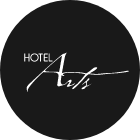
From Hotel Arts to the Bow River by Richard White
When people think of Calgary, many of them think modern office buildings as that is what dominates our skyline. But, once you get on the street and if you keep your eyes open, you will find there are lots of historical buildings that date back to Calgary’s early frontier years.
We asked Richard White, renowned for his blog @EverydayTourist, to share some of the history and background of the buildings in the surrounding neighbourhood of Hotel Arts. Richard has authored two walking tours for us – South Stroll and North Stroll.
North Stroll (45 to 60 minutes)
Turn left out the Front Doors at Hotel Arts and you’ll soon encounter First Street SW to begin the “North Stroll.” Turn right on First Street SW at the historic bank building where Formans Clothing now stands and you can stroll all the way North to the Bow River.
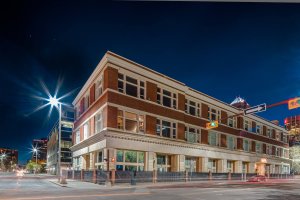
Manhattan Lofts
The current Manhattan Lofts building opened in 1911 as the English Pryce Jones Department Store, the only branch in Canada. The store closed in 1916 and served various purposes, including the Refinery Nightclub where live acts like B.B.King played until it was converted to loft condos in the early ‘90s.
Continue walking South, go through the underpass and up the other side to 9th Avenue SW.
Fairmont Palliser Hotel
The Fairmont Palliser Hotel, open in 1914 (an additional three floors and a penthouse were added in 1929), is an example of Edwardian Classical architecture and is one of the many grand hotels built in Canada by the Canadian Pacific Railway. It is named after Captain John Palliser who led the British scientific expeditions to the prairies from 1857 to 1860 to determine the agricultural potential of the land.
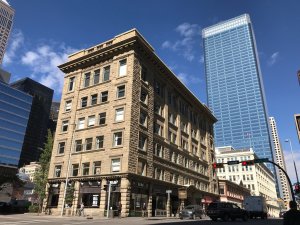
Grain Exchange
On the other corner of 9th Avenue and First Street SW is the majestic sandstone Grain Exchange Building constructed in 1909 by Calgary developer William Roper Hull, one of Calgary’s wealthiest ranchers at the time. Check out the pillar next to the main entrance and you will find the interlocking W, R and H letters Hull.
At six storeys, it was Calgary’s first skyscraper and the first to use reinforced concrete. The Calgary Grain Exchange was the building’s major tenant until 1919 when it needed more space and moved to the Lancaster Building. Today, it is home to an eclectic collection of small businesses, restaurants and artists’ studios. Open the doors and check out the lobbyas it is a definite walk back in time. If you wish, you could take the elevator to the top and walk down floor-by-floor to check out if any of the studios that are open.
Alberta Block
Next to the Grain Exchange is the Alberta Block built in 1903 built by Hull as a revenue-generating property but also as the office for his growing businesses. Hull sold his pioneer meat packing business to Patrick Burns and shifted his interest to real estate development. The building was designed by William Dodd who later designed Calgary’s old City Hall. In the early years, the building housed the Calgary Board of Trade, Co-operative Commonwealth Federation (precursor to the New
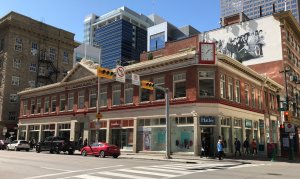
Democratic Party). In 1934, the corner became Jimmie’s Café, as Jimmie Condon a well-known confectioner, restaurateur and sports promoter took the space over. Legend has it Jimmie’s Café served Calgary’s first milkshakes.
Alberta Hotel
This Romanesque Revival building was completed in 1890, with additions in 1891 and 1906. The Alberta Hotel was a popular place for southern Alberta ranchers to stay when doing business in Calgary. It was in George Lane’s room, in 1912, that Guy Wedick pitched his idea for “Frontier Week” (which became the Calgary Stampede) to the “Big Four” ranchers including Lane.
Many major deals were done on a handshake at the Alberta Hotel. It is also famous for once having the longest bar in Western Canada at 125 feet. It was also home to R.B. Bennett for many years before he became the Prime Minister of Canada. Today, Murrieta’s West Coast Bar and Grill offers great food and a unique dining experience.
Built in 1913, with additions in 1930 and 1958, this Chicago style department store is actually Calgary’s fourth Hudson’s Bay Company store. If you look carefully, you can see that the terracotta façade and windows change slightly with the additions.
The store once had 40 departments, including a library, first aid facilities and a mezzanine area where patrons could sit, read and write letters (think texting) or meet up with friends. There was even a rooftop playground where shoppers could leave their children with the “governess” and go shopping.
It recently underwent renovation to allow for a major restaurant to be created on the main floor and under the colonnade along Stephen Avenue (aka 8th Ave SW).
Bank of Montreal
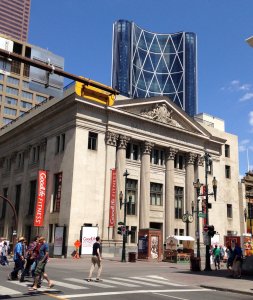
This Modern Classical building (1930) was designed by Kenneth G. Rae who designed more than 60 buildings for the Bank of Montreal, as well as the Montreal Stock Exchange building. The façade is Manitoba Tyndall Limestone – a popular building material in Western Canada as it contains many fossils creating a lovely mottled look. If you look up at the top of the entrance, you will see a relief artwork with two native men carrying the bank’s crest, with tipis and woods in the background.
Be sure to peek inside or enjoy a workout at GoodLife Fitness which now occupies this vast space.
A major fire destroyed the original church, in 1916, however, it was reconstructed in 1917 with the same Romanesque and Gothic Revival features, with additions in 1948, 1952 and 1956. Today, in addition to its church services, a library, a rec-centre, a hospital, a family, a sanctuary, a shelter, a kitchen, an incubator of imagination it is often used as a live music venue as it has excellent acoustics.
Brookfield Place is Calgary’s newest and tallest office tower in Western Canada at 54 stories. This elegant glass tower with rounded corners (only three manufacturers in the world could meet the specs for the building’s rounded glass edges) epitomizes modern minimalism architects’ belief that beauty is to be found in simplicity.
It has a lovely translucent glow in Calgary’s bright blue sky. Some say it looks a bit like a huge iPhone.
Grand Theatre
The Grand Theatre is housed in the historic Lougheed Block, which was built in 1912 when Calgary had a population of only 50,000 people. It was built as a multi-purpose commercial building, accommodating retail stores, offices, living quarters and The Grand Theatre. It was the biggest theatre in the Pacific Northwest at the time and attracted well-known performers such as Sarah Bernhart, Fred Astaire and George Burns. The Grand Theatre was the centre of Calgary’s social and political life and served as a venue for political rallies, debates, and speaking engagements.
The original Grand Theatre had 1,350 seats (810 on the main floor and 540 in the upper gallery) and boasted the largest stage in Canada when it first opened. In 1957, with the opening of The Southern Alberta Jubilee Auditorium, The Grand Theatre became a movie house for many years and even an indoor driving range for a few years, before Theatre Junction raised $12M to buy the building and then renovated and transformed it into a culture house (multi-purpose performance space) and home of the Theatre Junction Grand company.
The Suncor Energy Centre’s original name was the Petro Canada Centre. Built in 1983, it was the tallest building in Western Canada and was nicknamed “Red Square” as the then Liberal government had purchased Petro Fina with the idea of creating a national oil company.
When Suncor bought Petro Canada in 2010 they moved their offices from Sun Life Plaza across the street and the building was renamed Suncor Energy Centre. You should definitely go inside, as you will find a real bush plane hanging from the Lobby ceiling. The exterior is clad in stunning Taivassalo Granite imported from Finland.
Calgary Chinese Cultural Centre
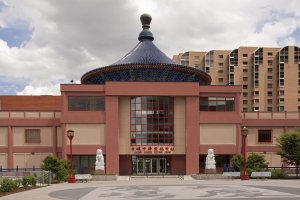
Walk two more blocks and you will see the blue dome of the Chinese Cultural Centre built in 1992. The blue tiles were imported from China and crafted by the same company that endowed the Temple of Heaven during the Ming Dynasty 600 years ago. Go inside and you will marvel at the ceiling with its 561 dragons and 40 phoenixes. The hall is modelled after the Hall of Prayers of the Temple of Heaven in Beijing.
First Street dead ends at Sien Lok sculpture park created in 1968. The name “Sien Lok” was taken from the proverb “wai sien gee look” (to be charitable gives one of the greatest happiness). The Sien Lok Society, in co-operation with the community, preserved and developed Chinatown’s lone green space into Sien Lok Park in 1982.
The sculpture titled “In Search of Gold Mountain” was sculpted by Chu Honsun from 15 tonnes of granite from Hopei Province in China. It was sculpted to honour the Chinese history within Canada.
From here you can wander to the Bow River pathway and check out the historic 1916 Centre Street Bridge, with its proud Lions.
Bow River
The Bow River starts at the Bow Glacier in the Rocky Mountains to the west of Calgary. It is renowned at one of the best fly-fishing rivers in the world. Don’t be surprised if you see someone fishing in the river. At certain times of the year, it can be emerald green as the result of being glacier water. Glacier water looks greens as it contains small bits of rock and minerals, known as “rock flour” resulting from the grinding action of the glacier. The sun’s light on these particles makes the water appear green.
There is a lovely multi-user pathway going east and west on both sides of the river, which can make for a very interesting stroll.
You can now circle back and walk back to Hotel Arts along First Street. Feel free to explore some of the side streets if you wish, as there are lots of other historic and contemporary buildings just a half a block in.




